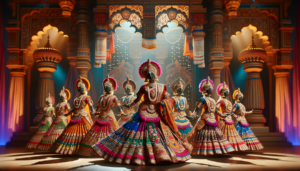Tap dance is a captivating and energetic dance style that has been entertaining audiences for generations. With its rhythmic footwork and intricate techniques, tap dance has evolved into a beloved art form enjoyed by dancers and spectators alike. Whether you’re a beginner looking to dive into the world of tap or simply curious about its history and techniques, this comprehensive guide will provide you with valuable insights and tips to get started on your tap dance journey.
The History of Tap Dance
Tap dance has a rich and fascinating history that spans several centuries. From its humble beginnings in the early 1800s to its current status as a respected dance genre, tap dance has undergone a remarkable evolution. Let’s explore the origins and development of this beloved art form.
Origins of Tap Dance
The roots of tap dance can be traced back to the fusion of African and European dance traditions. During the early 19th century, enslaved Africans brought their rhythmic dance styles to America, which combined with Irish step dancing and English clog dancing. This unique blend of cultures gave birth to the early forms of tap dance, characterized by percussive footwork and improvisational elements.
One of the earliest known tap dancers was William Henry Lane, also known as Master Juba. Born in 1825, Master Juba gained fame for his exceptional dancing skills and became one of the first black performers to achieve mainstream success in the United States. His style influenced the development of tap dance and paved the way for future generations of tap dancers.
Evolution of Tap Dance
As tap dance gained popularity, it began to evolve and take on new forms. In the early 20th century, vaudeville shows and Broadway productions showcased tap dancers, exposing the art form to wider audiences. During this time, tap dance incorporated elements of jazz music and became more structured and choreographed.
The 1920s and 1930s marked the golden age of tap dance, with legendary performers like Bill “Bojangles” Robinson, Fred Astaire, and the Nicholas Brothers taking center stage. These dancers brought tap to new heights with their innovative routines and technical prowess. They also helped to break down racial barriers in the entertainment industry, paving the way for future generations of diverse tap dancers.
In the 1940s and 1950s, tap dance faced a decline in popularity as other dance styles, such as modern dance and ballet, gained prominence. However, a resurgence occurred in the 1970s and 1980s, thanks to the efforts of tap dance pioneers like Gregory Hines, Savion Glover, and Dianne Walker. They brought new energy and creativity to the art form, incorporating elements of hip-hop and contemporary dance.
Notable Tap Dance Performers
Throughout its history, tap dance has been graced by numerous talented and influential performers. Some of the most notable names in tap dance include:
- Bill “Bojangles” Robinson: Known for his graceful style and signature stair dance, Robinson was one of the most famous tap dancers of the 1930s and 1940s.
- Fred Astaire: A legendary dancer and actor, Astaire’s sophisticated and elegant tap routines in Hollywood musicals set a new standard for the art form.
- The Nicholas Brothers: Fayard and Harold Nicholas were known for their acrobatic and explosive tap routines, often incorporating leaps and splits.
- Gregory Hines: Hines was instrumental in the tap dance resurgence of the 1970s and 1980s, bringing a new level of creativity and musicality to the art form.
- Savion Glover: A prodigy and innovator, Glover’s unique style incorporates elements of hip-hop and contemporary dance, pushing the boundaries of tap.
These performers, among many others, have left an indelible mark on the history of tap dance and continue to inspire new generations of dancers.
Techniques in Tap Dance
Tap dance is characterized by its intricate footwork and percussive sounds created by the dancer’s shoes. To excel in tap dance, it’s essential to master a range of techniques and steps. Let’s explore some of the fundamental techniques and moves in tap dance.
Basic Tap Dance Steps
Before diving into more advanced techniques, beginners should focus on mastering the basic steps of tap dance. These foundational moves form the building blocks for more complex routines and include:
- Toe Tap: Tapping the ball of the foot on the floor while keeping the heel raised.
- Heel Drop: Striking the floor with the heel while keeping the ball of the foot raised.
- Shuffle: A combination of a brush forward and a spank back, creating a “shhh” sound.
- Flap: A brush forward followed by a step, creating a “fuh-lap” sound.
- Ball Change: Shifting weight from one foot to the other, with a slight bounce in between.
Practicing these basic steps repeatedly helps to develop muscle memory and coordination, laying the foundation for more advanced techniques.
Advanced Tap Dance Techniques
As dancers progress in their tap dance journey, they can explore more advanced techniques that add complexity and flair to their routines. Some of these techniques include:
- Wings: A rapid, alternating heel-toe movement that creates a fluttering sound.
- Pullbacks: A sliding motion where the foot is pulled back across the floor, often used for transitions.
- Cramp Rolls: A series of rapid, alternating heel drops and toe taps, creating a continuous rolling sound.
- Time Steps: A rhythmic combination of steps performed in a specific time signature, often used in choreography.
- Tricks and Acrobatics: Advanced dancers may incorporate leaps, turns, and acrobatic elements into their routines for added visual impact.
Mastering these advanced techniques requires dedication, practice, and guidance from experienced tap dance instructors. Attending workshops, classes, and performances can help dancers refine their skills and learn new techniques.
Improvisation in Tap Dance
Improvisation is a crucial aspect of tap dance, allowing dancers to express their creativity and musicality. Tap dancers often engage in “trading fours” or “cutting contests,” where they take turns improvising short phrases to showcase their skills and respond to each other’s movements.
To develop improvisational skills, tap dancers should focus on listening to the music, internalizing rhythms, and exploring different combinations of steps and sounds. Practicing with live musicians or recorded tracks can help dancers develop a sense of timing and musicality.
Improvisation also requires a willingness to take risks and step outside of one’s comfort zone. Tap dancers should embrace the opportunity to experiment with new ideas and movements, even if they don’t always work out as planned. The beauty of improvisation lies in the spontaneity and uniqueness of each performance.
Tips for Beginners in Tap Dance
If you’re new to tap dance, starting your journey can be both exciting and overwhelming. Here are some tips to help you get started on the right foot and make the most of your tap dance experience.
Choosing the Right Tap Dance Shoes
Having the right tap dance shoes is essential for producing clear sounds and executing techniques properly. When selecting tap shoes, consider the following factors:
- Fit: Tap shoes should fit snugly without being too tight. Your toes should have some room to move, but your foot shouldn’t slide around inside the shoe.
- Material: Tap shoes are typically made of leather or synthetic materials. Leather shoes are more durable and mold to the shape of your foot over time, while synthetic shoes are often more affordable.
- Sole: The sole of the tap shoe should be flexible enough to allow for easy movement but sturdy enough to support the taps.
- Taps: Tap shoes come with metal taps attached to the toe and heel. Beginners should start with standard taps and can explore different sounds and materials as they progress.
It’s important to try on tap shoes in person to ensure a proper fit. Many dance supply stores offer professional fitting services to help you find the right pair of shoes for your needs.
Finding Tap Dance Classes
Taking tap dance classes is the best way to learn proper technique, receive feedback, and progress in your skills. When looking for tap dance classes, consider the following:
- Level: Look for classes that match your skill level, whether you’re a complete beginner or have some previous dance experience. Many studios offer classes for different levels, from beginner to advanced.
- Instructor: Research the instructor’s background and experience. Look for teachers who have professional training, performance experience, and a proven track record of working with students at your level.
- Class Size: Smaller class sizes allow for more individual attention and feedback from the instructor. However, larger classes can provide a sense of community and the opportunity to learn from your peers.
- Location and Schedule: Choose a class that fits your schedule and is conveniently located. Consider factors such as travel time, parking, and public transportation when making your decision.
Many dance studios offer trial classes or drop-in options, allowing you to experience a class before committing to a full session. Take advantage of these opportunities to find the right fit for your learning style and goals.
Practicing Tap Dance at Home
While taking classes is essential, practicing tap dance at home is equally important for developing your skills and muscle memory. Here are some tips for practicing tap dance at home:
- Create a Practice Space: Find a suitable space in your home for practicing, such as a hardwood floor or a portable tap dance board. Ensure that the surface is even and free of obstacles.
- Warm Up: Begin each practice session with a proper warm-up to prevent injury and prepare your body for dancing. Include stretches for your ankles, calves, and hamstrings.
- Break Down Steps: When learning a new step or combination, break it down into smaller parts. Practice each part slowly and gradually increase the speed as you become more comfortable.
- Use Music: Practice your steps and routines with music to develop your timing and musicality. Start with slower tempos and gradually increase the speed as you improve.
- Record Yourself: Recording your practice sessions can help you identify areas for improvement and track your progress over time. Use your phone or a video camera to capture your dancing and review the footage.
Remember, consistency is key when practicing tap dance. Set aside dedicated time each day or week to work on your skills, even if it’s just for a short period. Regular practice will help you build strength, coordination, and confidence in your dancing.
Tap Dance Performances and Community
Tap dance is not only a personal pursuit but also a vibrant community of dancers, choreographers, and enthusiasts. Engaging with the tap dance community can provide inspiration, support, and opportunities to grow as a dancer.
Popular Tap Dance Performances
Watching tap dance performances is a great way to gain exposure to different styles, techniques, and choreography. Some popular tap dance performances include:
- “Tap Dogs”: Created by Australian choreographer Dein Perry, “Tap Dogs” is a high-energy show that combines tap dance with industrial sets and live music.
- “Bring in ‘da Noise, Bring in ‘da Funk”: This Tony Award-winning musical, starring Savion Glover, explores the history of African-American culture through tap dance and music.
- “Stomp”: While not exclusively a tap dance show, “Stomp” incorporates elements of tap and percussive dance using unconventional objects as instruments.
- Tap dance festivals: Many cities host annual tap dance festivals that showcase performances by local and international artists. These events often include workshops and classes for dancers of all levels.
Attending live performances and events can provide inspiration and exposure to the diverse world of tap dance.
Engaging with the Tap Dance Community
Connecting with other tap dancers and enthusiasts can provide support, motivation, and opportunities for growth. Here are some ways to engage with the tap dance community:
- Social Media: Follow tap dancers, studios, and organizations on social media platforms like Instagram, Facebook, and Twitter. Many dancers share videos, tips, and insights into their training and performances.
- Online Forums: Join online forums and discussion groups dedicated to tap dance. These platforms provide a space to ask questions, share experiences, and connect with dancers from around the world.
- Local Dance Communities: Research local dance studios, performance groups, and organizations in your area. Attend events, take classes, and volunteer to get involved in your local tap dance community.
- Workshops and Intensives: Participate in tap dance workshops and intensives taught by professional dancers and choreographers. These events provide opportunities to learn new skills, network with other dancers, and gain exposure to different teaching styles.
Building connections within the tap dance community can lead to friendships, collaborations, and even professional opportunities. Embrace the supportive and inclusive nature of the tap dance world and don’t be afraid to reach out and get involved.
Attending Tap Dance Events
Tap dance events, such as festivals, competitions, and showcases, provide opportunities to immerse yourself in the art form and connect with other dancers. When attending tap dance events, keep the following in mind:
- Research the Event: Look up information about the event, including the schedule, performers, and workshops offered. Plan your attendance based on your interests and goals.
- Prepare Yourself: Bring comfortable clothing, dance shoes, water, and any other essentials you may need throughout the day. If you plan to take classes or workshops, arrive early to warm up and get settled.
- Be Open-minded: Tap dance events expose you to a wide range of styles, levels, and perspectives. Approach each experience with an open mind and a willingness to learn from others.
- Network and Socialize: Take advantage of the opportunities to meet other dancers, instructors, and industry professionals. Introduce yourself, ask questions, and exchange contact information to stay connected after the event.
Attending tap dance events can be a transformative experience, providing inspiration, knowledge, and a sense of community. Embrace the opportunity to immerse yourself in the vibrant world of tap dance and make lasting connections with fellow dancers.
Tap Dance in Media
Tap dance has a significant presence in various forms of media, including videos, movies, and television shows. These platforms provide opportunities to watch and learn from talented tap dancers, as well as to gain exposure to different styles and choreography.
Tap Dance on YouTube
YouTube has become a valuable resource for tap dancers of all levels. Many tap dancers and studios maintain YouTube channels where they share tutorials, performances, and behind-the-scenes content. Some popular tap dance YouTube channels include:
- Operation Tap: Created by tap dancer and instructor Sarah Reich, Operation Tap offers tutorials, improvisation prompts, and interviews with tap dance professionals.
- Chloe Arnold’s Syncopated Ladies: Led by choreographer Chloe Arnold, this channel features performances and choreography by the all-female tap dance group, Syncopated Ladies.
- Tap Dance Tutorials by Rod Ferrone: Tap dancer and instructor Rod Ferrone shares detailed tutorials and breakdowns of various tap dance steps and combinations.
Subscribing to tap dance YouTube channels and exploring their content can provide a wealth of knowledge and inspiration for your own tap dance journey.
Tap Dance in Movies and TV Shows
Tap dance has been featured in numerous movies and television shows throughout history. These appearances have helped to popularize tap dance and showcase its versatility as an art form. Some notable examples include:
- “Singin’ in the Rain” (1952): This classic movie musical features Gene Kelly’s iconic tap dance performance of the title song.
- “The Cotton Club” (1984): Set in the 1930s, this film showcases the tap dance talents of Gregory Hines and his brother Maurice Hines.
- “Happy Feet” (2006): This animated movie follows the story of a tap-dancing penguin named Mumble, featuring the voice and motion-capture performances of Savion Glover.
- “So You Think You Can Dance”: This long-running dance competition show has featured numerous tap dancers over the years, exposing audiences to the art form and providing a platform for emerging talents.
Watching tap dance in movies and television shows can provide entertainment, inspiration, and a deeper appreciation for the art form’s history and cultural significance.
Tap dance continues to evolve and thrive in media, with new videos, movies, and shows featuring the art form emerging regularly. As a tap dance enthusiast, staying connected to these platforms can keep you informed and inspired as you pursue your own tap dance journey.
In conclusion, tap dance is a vibrant and dynamic art form with a rich history, diverse techniques, and a thriving community of practitioners. Whether you’re a beginner looking to start your tap dance journey or an experienced dancer seeking to deepen your knowledge and skills, the world of tap dance offers endless opportunities for growth, creativity, and connection.
By understanding the history and evolution of tap dance, mastering fundamental techniques, and engaging with the tap dance community, you can cultivate a lifelong passion for this incredible art form. Remember to approach your tap dance journey with patience, dedication, and an open mind, and don’t be afraid to take risks and express your unique style and personality through your dancing.
As you continue to explore and grow as a tap dancer, embrace the challenges and triumphs that come with the territory. Celebrate the rich legacy of tap dance and its countless contributors, from the early pioneers to the contemporary innovators who continue to push the boundaries of what’s possible.
So put on your tap shoes, find your rhythm, and let your feet do the talking. The world of tap dance awaits, and with each step, you’ll be joining a global community of artists, athletes, and enthusiasts united by their love for this timeless and captivating art form.
#ED#






